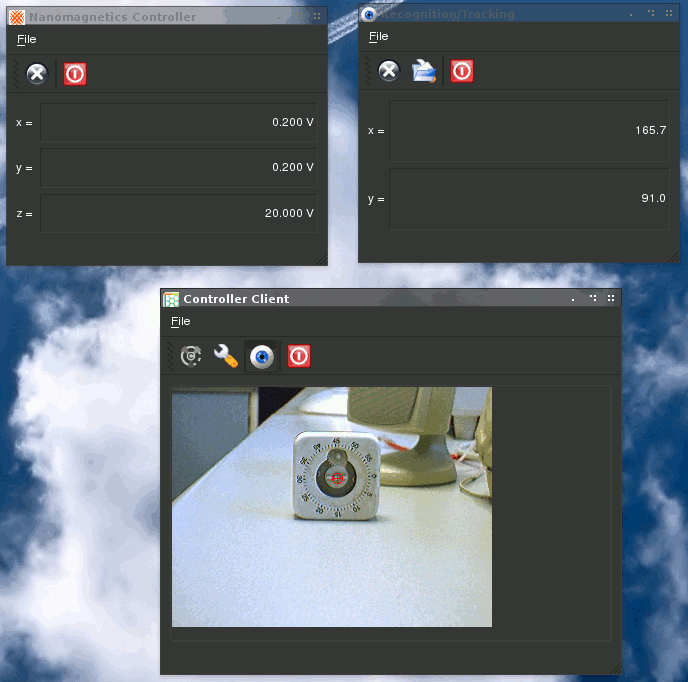TEM vision software
m (→External Links) |
m |
||
| Line 11: | Line 11: | ||
|- | |- | ||
|} | |} | ||
| − | As part of the [[Nanorobotics]] project a [[TEM vision software]] was developed. The software makes use of | + | As part of the [[Nanorobotics]] project a [[TEM vision software]] was developed. The software makes use of a [http://www.jeolusa.com/PRODUCTS/ElectronOptics/TransmissionElectronMicroscopesTEM/300kV/JEM3010/tabid/213/Default.aspx JEOL 3010] transmission microscope with a [http://tvips.com/Prod_F114.php TVIPS FastScan-F114 camera] which is an IIDC/DCAM-compatible firewire camera. The nano-indenter is controlled by a [http://web.nanomagnetics-inst.com/product_detail.php?product_link=SPM Nanomagnetics SPM controller] (the old version of the controller can be accessed with a [http://www.mccdaq.com/pci-data-acquisition/PCI-DIO24.aspx PCI-DIO24 card]). |
The software runs under GNU/Linux and it makes use of [http://damien.douxchamps.net/ieee1394/libdc1394/ Damien Douxchamps' libdc1394] to access the camera and [ftp://lx10.tx.ncsu.edu/pub/Linux/drivers/ Warren Jasper's PCI-DIO24 driver] to access the PCI-card which interfaces with the SPM controller. | The software runs under GNU/Linux and it makes use of [http://damien.douxchamps.net/ieee1394/libdc1394/ Damien Douxchamps' libdc1394] to access the camera and [ftp://lx10.tx.ncsu.edu/pub/Linux/drivers/ Warren Jasper's PCI-DIO24 driver] to access the PCI-card which interfaces with the SPM controller. | ||
Revision as of 18:30, 26 June 2009
|
Demonstration of TEM vision software including telemanipulation as well as closed-loop control using machine-vision feedback (also available as DivX3 videos configuration.avi (64 MByte), closed-loop.avi (44 MByte), and interaction.avi (19 MByte)) |
 Prototype using Distributed Ruby for vision-based closed-loop control |
As part of the Nanorobotics project a TEM vision software was developed. The software makes use of a JEOL 3010 transmission microscope with a TVIPS FastScan-F114 camera which is an IIDC/DCAM-compatible firewire camera. The nano-indenter is controlled by a Nanomagnetics SPM controller (the old version of the controller can be accessed with a PCI-DIO24 card).
The software runs under GNU/Linux and it makes use of Damien Douxchamps' libdc1394 to access the camera and Warren Jasper's PCI-DIO24 driver to access the PCI-card which interfaces with the SPM controller.
The software was implemented in Ruby using Qt4-QtRuby, HornetsEye, and a custom Ruby-extension to access the SPM controller via the PCI-DIO24 card. Distributed Ruby and multiple processes were used to work around the problem that Ruby-1.8 does not offer native threads.
The vision algorithms are configured using a separate program and the configuration is saved in a file using Ruby marshalling. A plugin-based architecture, which accepts plugins for recognition and tracking, was implemented which allows one to select and configure Normalised Cross-Correlation, Lucas-Kanade tracking, or Connected Component Analysis.
Future Work
Possible future work is
- port to Ruby-1.9 which has native threads
- integrate serial-port interface of JEOL TEM
See Also
External Links
- Hardware
- Software
- Related publications
- Jung-Me Park, C. G. Looney, Hui-Chuan Chen: Fast connected component labeling algorithm using a divide and conquer technique, 15th International Conference on Computers and their Applications, March, 2000, pp. 373-6
- J. P. Lewis: Fast Normalized Cross-Correlation, Industrial Light & Magic
- S. Baker, I. Matthews: Lucas-Kanade 20 Years On: A Unifying Framework, International Journal of Computer Vision, Vol. 56, No. 3, March, 2004, pp. 221-255.